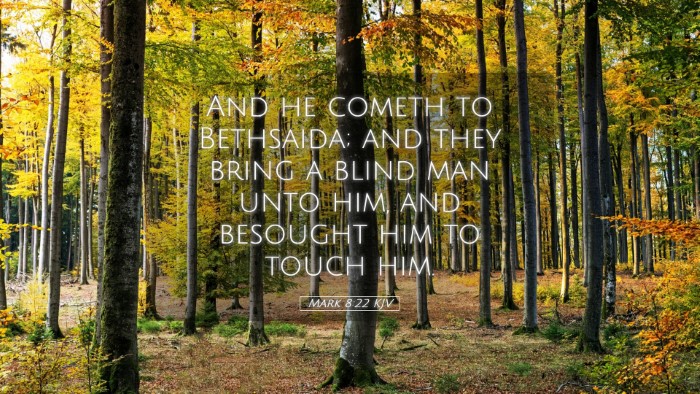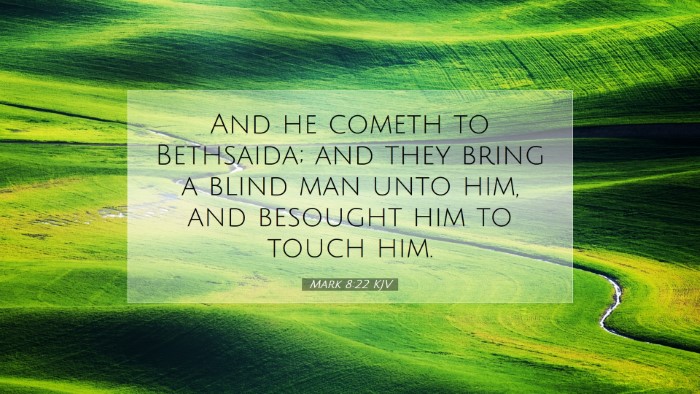Commentary on Mark 8:22
Bible Verse: "And he cometh to Bethsaida; and they bring a blind man unto him, and besought him to touch him." (Mark 8:22, KJV)
Introduction
This passage marks a significant moment in the Gospel of Mark, as it reveals not only the compassion of Christ but also serves as a profound commentary on faith, healing, and spiritual sight. Throughout the biblical narrative, the healing of the blind is emblematic of the transition from spiritual darkness to light, paralleling the journey of the disciples and the audiences who are confronted with the identity of Jesus.
Contextual Analysis
Bethsaida, the town mentioned in this verse, has a rich historical and geographical significance. It was a place associated with several miracles of Jesus, reflecting a ministry that was deeply engaged with the needs of individuals. The presence of a blind man who is brought to Jesus signifies the communal aspect of faith; it demonstrates the intercessory role of the community in seeking healing and hope.
Reliance on Christ
Matthew Henry emphasizes that the blind man's condition symbolizes spiritual blindness. Just as the physical blindness necessitates a reliance on others for assistance, so too does spiritual blindness require divine intervention. The act of bringing the blind man to Jesus showcases the faith of those who sought healing not only for themselves but also for others.
Public Desperation for Help
Albert Barnes points out that the collective act of beseeching Jesus demonstrates a public acknowledgment of His power and authority. The crowd acted with an earnestness that reflects their desperation for relief from suffering. This plea mirrors the attitudes of many seeking spiritual and physical healing, and highlights a crucial lesson for the Church: active intercession is vital for those in need.
The Nature of the Miracle
In this passage, the manner in which Jesus healed the blind man is instructive. He does not simply will the man's sight to return, but rather involves a process that includes touch, leading to a gradual renewance of sight. Adam Clarke comments on the significance of this method, emphasizing that Jesus chooses to engage the man actively, highlighting the importance of personal interaction and the tactile nature of faith.
Process of Healing
The sequential nature of the healing, wherein the man's sight is restored in stages, offers profound insights into the nature of faith and healing. It suggests that sometimes God’s work in our lives occurs gradually rather than instantaneously, a reminder that faith can develop and progress over time. Such an understanding encourages believers to remain patient in their spiritual journeys.
Theological Implications
This miracle not only showcases Jesus’ power over physical ailments but also serves as a metaphor for the spiritual enlightenment and the transition from ignorance to faith. The healing of the blind man parallels the larger narrative of the disciples, who often struggled to see Jesus for who He truly was despite being in His presence.
Spiritual Insight
Henry elucidates that this passage reminds believers of their own spiritual blindness prior to divine intervention. Just as the blind man was unable to see without help, humanity is often blind to the truth of God’s revelation without the illuminating work of the Holy Spirit. This healing therefore serves as a dual narrative: a physical healing that underscores the necessity of spiritual insight for all who follow Christ.
Community and Faith
Barnes draws attention to the collective faith displayed by those who brought the blind man forward. This calls on the Church today to embody a spirit of community where the weak are supported, and faith is collectively exercised. The act of bringing someone else to Jesus is foundational to the mission of the Church, as it illustrates the importance of evangelism and mutual support in faith.
Conclusion
Mark 8:22 captures a moment of profound significance that resonates throughout the Scripture. It is a call to recognize our own spiritual blindness and to seek the healing touch of Christ. Furthermore, it challenges the Church to remain bold in intercession and committed to bringing the lost and hurting into the light of Christ.
In understanding this passage, we embrace the dual nature of Christ's ministry: He is both a healer of physical ailments and a restorer of spiritual sight, inviting every believer to participate in this transformative process. As we consider the implications of this passage, may we continually seek to be instruments of healing and light in a world that desperately needs both.


